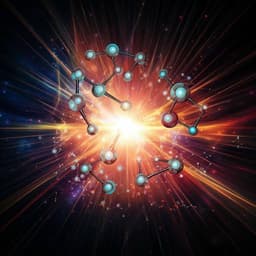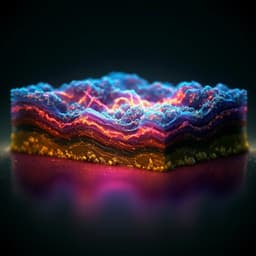
Physics
Terahertz spectroscopy of collective charge density wave dynamics at the atomic scale
S. Sheng, M. Abdo, et al.
This groundbreaking research by Shaoxiang Sheng and colleagues utilizes terahertz pump-probe spectroscopy to explore ultrafast charge density wave dynamics in 2H-NbSe₂ at atomic-scale resolution. By uncovering how atomic impurities influence these oscillations, this study offers fascinating insights into the intricate dance of electron density modulations.
~3 min • Beginner • English
Introduction
Many metallic and semimetallic systems develop charge order at low temperature due to electron–phonon coupling, especially in low dimensions. In incommensurate charge density waves (CDWs), a wave-like modulation of charge and lattice emerges with collective amplitude and phase dynamics. Ideal incommensurate CDWs should host a gapless Nambu–Goldstone phase mode, but real materials contain disorder and impurities that pin the CDW, induce spatial heterogeneity, and strongly modify low-energy collective dynamics. Prior local STM imaging showed defect pinning of CDWs, while ensemble-averaged techniques indicated low-frequency phase excitations, but direct, real-space observation of phase excitation dynamics at the atomic scale has been lacking. This study aims to directly excite and detect ultrafast, low-energy CDW phase dynamics in 2H-NbSe2 with atomic spatial resolution, and to reveal how randomly distributed atomic defects shape these dynamics.
Literature Review
Previous work established CDW formation via electron–phonon coupling and discussed commensurate versus incommensurate CDWs and their collective modes. In NbSe2, Raman spectroscopy measured the amplitude (Higgs) mode near 1.2 THz, but phase dynamics remained elusive optically. Ensemble probes reported low-energy phase-related dynamics: neutron scattering found dispersing phase excitations down to ~0.25 THz; ultrafast low-energy electron diffraction observed slow phase ordering; transport noise indicated phase sliding across pinning potentials; and X-ray/optical spectroscopies reported picosecond relaxation attributed to phase fluctuations. STM has imaged CDW pinning at individual defects in NbSe2 and related dichalcogenides. However, far-field optical spectroscopy likely misses highly heterogeneous, defect-localized low-frequency modes due to spatial averaging. These gaps motivate a local, ultrafast probe capable of resolving spatiotemporally varying phase excitations.
Methodology
Experimental platform: A home-built low-temperature STM is combined with ultrafast single-cycle terahertz (THz) pump–probe pulses (generated by optical rectification of 250 fs, 1032 nm pulses in LiNbO3 with tilted pulse front). The THz beam is focused onto the STM tip; strong tip enhancement produces junction fields >1 MV/cm from a far-field peak of 130 V/cm (41 MHz repetition). The THz waveform at the junction is characterized by electro-optic sampling of THz light scattered from the tip using a ZnTe crystal; the measured pulse is single-cycle with spectral content extending beyond 1 THz. Samples: 2H-NbSe2 crystals are cleaved in UHV and measured at 20 K (CDW phase) and 150/141 K (normal metal phase). THz pump–probe time traces: The NIR beam is split 50:50 to form two THz pulses with adjustable delay (−2 to +23.3 ps, 0.2 ps steps). One pulse (excitation) precedes a chopped sensing pulse for lock-in detection of the THz-induced tunnel current I_THz at the sensing-pulse frequency with STM feedback off and dc bias 0 V. The overlap-induced pulse–pulse correlation near zero delay is present in both phases. For spectral analysis, the oscillatory portion (excluding short delays) is windowed and FFT’d to obtain power spectral density (PSD). Spatial mapping: While scanning with feedback on and a small dc bias, THz amplitude is modulated by overlapping pulse pairs at 300 fs delay; lock-in detection yields a spatial map of the THz-induced current response simultaneously with topography. Spatially resolved PSD maps are acquired by recording time traces along a line and computing position-dependent FFTs (with Gaussian spatial averaging). Electric-field dependence: Excitation pulse amplitude is varied with an acousto-optic modulator while keeping the sensing pulse constant; decay amplitudes and time constants are extracted by single-exponential fits excluding the overlap region. Control and separation of non-CDW signals: The rectified current from the nonlinear I(V) is computed from the measured THz waveform and static I(V), accounting for the zero-delay dip–peak and peaks near 0.45–0.6 THz. Subtracting this calculated correlation verifies that the low-frequency oscillations are not due to rectification. Modeling: An extended time- and position-dependent Ginzburg–Landau framework with Drude-like conductivity describes THz-induced screening current as a damped acceleration of the CDW phase and Joule heating that modifies the free energy. Random localized pinning potentials emulate atomic defects that locally favor specific CDW phase. Simulations yield spatially resolved phase dynamics and PSDs for comparison with experiment.
Key Findings
- THz pump–probe STM reveals ultrafast CDW dynamics in 2H-NbSe2 with atomic spatial resolution. At 20 K (CDW phase), time traces show an ultrafast decay followed by oscillations persisting to at least 20 ps; at 150 K (normal metal), oscillations are much weaker.
- Distinct CDW-only low-frequency modes: In the CDW phase, prominent PSD peaks appear at ~0.15 THz and between ~0.6–0.9 THz with spectral weight more than five times higher than in the normal metal phase. In the normal metal, spectral weight concentrates at ~0.22 THz, ~0.45 THz and ~1.1 THz (attributed to rectification/phonons), with little intensity below 0.3 THz.
- The calculated pulse–pulse correlation and measured THz waveform explain the zero-delay dip–peak and PSD features near ~0.5–0.6 THz but cannot account for the sub-0.3 THz oscillations or 0.6–0.9 THz band, confirming their CDW origin.
- Electric-field-driven excitation and relaxation: Increasing excitation field raises the decay amplitude approximately linearly from ~0.05 pA to ~0.41 pA and reduces the decay constant from 1.7 ± 0.2 ps to 0.6 ± 0.1 ps, consistent with ultrafast electron-bath heating. CDW-related PSD intensities at ~0.16 THz and 0.6–0.9 THz increase approximately quadratically with field.
- Tip retraction by 2.1 Å reduces tunneling probability by ~100×, yet the decay constant stays ~0.7 ± 0.2 ps and the relative amplitude drops only ~2×, indicating direct electric-field driving via THz-induced screening currents rather than tunneling electrons.
- Estimated screening current density near the tip apex reaches ~1×10^8 A/cm^2 at a center frequency ~0.55 THz; local Joule heating transiently elevates the electron temperature, driving nonequilibrium CDW states.
- Spatial heterogeneity linked to defects: Spatial maps show strong positive or negative THz-induced signals correlated with local defect density. Position-resolved PSDs reveal that sub-0.5 THz modes are stronger and extend over several CDW unit cells in defect-rich regions (on ~nanometer scales), while 0.6–0.8 THz peaks appear more locally over ~1 nm.
- Direct measurements at single defects show suppression of CDW-related spectral weight directly atop a phase-pinning defect compared to ~1 nm away (more than a factor of 2 reduction), consistent with the model prediction.
- Modeling with an extended Ginzburg–Landau approach reproduces heterogeneous low-frequency phase excitations arising from overlapping defect-launched phase waves. Fitting to the experimental band (0.15–0.8 THz) yields a phase-excitation group velocity of ~3.2 nm/ps, consistent with expected CDW phason velocities.
- Time resolution better than ~0.4 ps; CDW amplitude mode at ~1.2 THz (known from Raman) is not the dominant feature here; instead, observed sub-THz modes are assigned to local phase excitations.
Discussion
The study directly addresses the longstanding challenge of observing CDW phase dynamics in real space. By using tip-enhanced THz fields to launch and locally probe dynamics, the authors reveal defect-enabled low-energy phase excitations that are highly heterogeneous on nanometer scales. The suppression of spectral weight at defect centers and enhanced response in their vicinity, together with the spatially varying frequencies and amplitudes, confirms the central role of pinning in shaping phase dynamics. The absence of these modes in the normal metal state, their quadratic scaling with excitation field, and the persistence after subtracting rectification contributions support their assignment to CDW phase excitations rather than electronic rectification or phonons. The extended Ginzburg–Landau model captures the essential physics of THz-driven phase acceleration, Joule heating, and relaxation via propagating phase excitations launched at defects, explaining why far-field optical probes fail to detect these modes due to spatial averaging. The extracted group velocity aligns with expectations for phasons in CDWs, reinforcing the interpretation. These results advance understanding of how disorder intertwines with collective charge order dynamics and establish a platform for nanoscale, ultrafast studies of correlated materials.
Conclusion
THz pump–probe STM provides atomic-scale, ultrafast access to CDW dynamics in 2H-NbSe2. The experiment identifies defect-enabled, low-energy phase excitations at ~0.15 THz and 0.6–0.9 THz that are absent in the normal metal phase, exhibit strong spatial heterogeneity, and scale with excitation field. A qualitative extended Ginzburg–Landau model explains their origin as overlapping phase waves launched at defects by THz-induced screening currents and transient heating, and yields a phase-excitation group velocity of ~3.2 nm/ps. This methodology opens a route to locally image and control collective dynamics in correlated materials. Future work could leverage electric-field-driven THz excitation to visualize phase boundary motion in metal–insulator transitions, explore nanoscale fluctuations in 2D magnets, study pair-breaking dynamics in superconductors, and investigate the interplay between CDW order and competing phases such as superconductivity.
Limitations
- The theoretical model employs a random pinning landscape tuned to the observed defect density but does not reproduce the exact sample-specific pinning potentials; it is qualitative and not a quantitative fit to data.
- The THz-induced screening current and local field enhancement are estimated; while the THz waveform is measured via tip-scattered light, precise junction field and current densities carry uncertainties.
- Non-CDW signals (e.g., rectification and possible phonons near ~0.45 and ~1.1 THz) are present; although analyzed and subtracted where possible, complete separation may be imperfect.
- Spatial heterogeneity implies that results are strongly location dependent; broader statistical mapping would be needed for comprehensive generalization.
- The frequency window is limited by the measurement bandwidth and analysis range (primarily 0.15–0.9 THz for CDW-related modes); the amplitude (Higgs) mode near ~1.2 THz is not the focus here.
Related Publications
Explore these studies to deepen your understanding of the subject.







